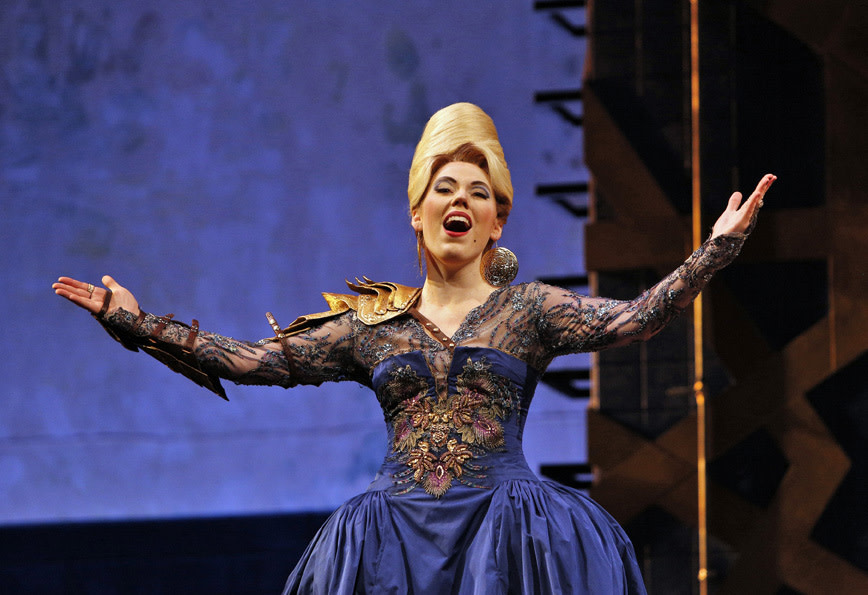Review: Portland Opera’s "Rinaldo"

Soprano Lindsay Ohse steals the show with her vindictive prom queen take on the evil sorceress Armida. Photo by Cory Weaver.
In other words, it’s like Terry Gilliam got hold of Handel’s masterpiece to create The Adventures of Rinaldo Munchausen. And the result is utterly charming. Backed by the expert playing of the Portland Baroque Orchestra in the intimate Newmark Theatre, it is very likely the standout show of the opera’s season.
Of course, Rinaldo is a story that lends itself to—if not outright requires—fantastical, Gilliam-esque treatment. Written by Handel in 1711 with the purpose of introducing England to the trends of Italian opera, including elaborate sets and special effects, it tells the story of a knight templar whose betrothed is kidnapped by an evil sorceress, who happens to be the lover of Rinaldo’s enemy, the King of Jerusalem (which doesn't stop her from falling for Rinaldo). Rinaldo, of course, undertakes a great quest involving demons, mermaids, and witchcraft to win his love back—although for the most part it involves a lot of posturing and poor decisions with no sword play whatsoever.
Rinaldo
Portland Opera
Newmark Theatre
March 15, 17, 19, 21 & 23
It’s the kind of tale that could easily kill the budget, but set and costume designer Jacob Climer tackles it with endless creativity. The backdrop is a giant tiled wall with openings at multiple levels, allowing it to transform from a palace to the ocean to a mountain with the help of a few imaginative props like a miniature castle or a puppet ship (in said wig). The attention to detail in the costumes, from the Ouija Board tattoo on the chest of the Christian sorcerer to the three-piece suits (tailored by local Duchess Clothier), is also playfully meticulous.
Not to be outdone, stage director Chas Rader-Shieber brings the space to shimmering, campy life with energetic blocking and choreography that’s equal parts silent film melodrama and ‘80s glam music video (I half expected Prince to emerge for a steamy harpsichord solo). The final scene, consisting of one of the the best art direction jokes I've seen (spoiler alert: the sea battle is instead a giant game of Battleship), shows that a little ingenuity can go a long way in creating a fully realized, engaging world.
The production is so imaginative, in fact, that it could easily overshadow the performances, if they too were not strong. Sopranos Sharin Apostolou and resident artist Lindsay Ohse steal the show. Apostolou plays Rinaldo’s beloved, Almirena, as an earnest yet saucy princess, her winks and hard-to-get antics winning many a laugh. But she just as easily captures the pain and sorrow of her abduction: during the classic aria “Let Me Weep,” the notes of the violins and theorbo (an ancestor of the guitar) seem to fall from her crystalline vocal heights like tears. Ohse’s Armida, on the other hand, is the preening, vindictive prom queen whose ego can’t handle rejection, and whose singing is sly, soaring, and gorgeous. Resident artists Matthew Grills and André Chiang also give strong performances as the rival Christian captain and King of Jerusalem.
If there is a weakness, it lies in the casting of Rinaldo and his fellow soldier, Eustazio. Originally written for a castrato, the role of Rinaldo has become a de facto breeches role (a woman, generally a mezzo soprano, playing a man), although artistic director Christopher Mattaliano told me during intermission that the casting choice was simply the matter of wanting to give a leading role to exiting resident artist Caitlin Mathes. While Mathis’s pompadour can’t compete with Almirena’s and Armida’s heels (both comically tower over her), her acting, strutting around like a drag king peacock, is up to snuff (if coming down on the campy side). But her voice, while lovely, doesn’t have the volume and ferocity to capture Rinaldo in his moments of rage and loss, and it muddies some in her duets with the sopranos. Hannah Penn as Eustazio seems to struggle even more in hitting her low notes.
But those are small complaints. While I can imagine opera stalwarts grumbling about the anachronistic, almost Clueless-style characterizations of the female characters, I found the show overall to be a magnificent mishmash of styles and periods that balances contemporary-infused humor with Baroque beauty to create a magical fairy tale capable of entertaining both opera veterans and neophytes alike.




